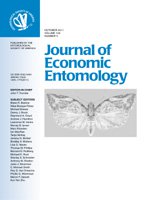To help assess the potential for damage by armyworms [Mythimna (Pseudaletia) unipuncta (Haworth) (Lepidoptera: Noctuidae)] to switchgrass (Panicum virgatum L.) and surrounding crops, survival and development were evaluated for larvae reared on leaves of switchgrass, corn (Zea mays L.), and miscanthus (Miscanthus × giganteus Greef and Deuter ex Hodkinson and Renvoize). Additional tests assessed the relationship between leaf position and the concentration of saponins (plant compounds which can provide protection from insect herbivores) and examined the effect of defoliation on switchgrass dry mass. Survival to adulthood was similar when larvae were reared on field-grown leaves of switchgrass and corn. However, lower larval mass (10 d) and delayed development of M. unipuncta (to pupation, adult emergence) suggest switchgrass is an inferior host relative to corn. When fed field-grown miscanthus, no larvae survived 10 d. Few differences were noted between switchgrass and corn grown under controlled (laboratory) conditions, but M. unipuncta survival seemed to decline rapidly when larvae were fed the fourth and fifth leaves of switchgrass. Switchgrass leaf samples collected from different leaf positions and stages of tiller maturity showed up to 10-fold differences in the concentration of the saponin protodioscin, with the greatest concentrations in the fourth and fifth leaves. However, other saponins showed an opposite pattern, indicating the role of protodioscin on insect development should be tested in isolation (e.g., by addition of the purified compound to an artificial diet). Defoliation trials indicated that extremely high M. unipuncta populations may be necessary to cause any significant reduction in switchgrass biomass. Collectively, results suggest M. unipuncta may not present a significant risk to biomass production in switchgrass, but that the spring emergence of switchgrass provides an alternate host for M. unipuncta before colonizing annual food and feed crops.
How to translate text using browser tools
1 October 2011
Relative Feeding and Development of Armyworm on Switchgrass and Corn, and Its Potential Effects on Switchgrass Grown for Biomass
J. R. Prasifka,
J. D. Bradshaw,
S. T. Lee,
M. E. Gray
ACCESS THE FULL ARTICLE
It is not available for individual sale.
This article is only available to subscribers.
It is not available for individual sale.
It is not available for individual sale.

Journal of Economic Entomology
Vol. 104 • No. 5
October 2011
Vol. 104 • No. 5
October 2011
Bioenergy
defoliator
ethanol
pest
resistance




